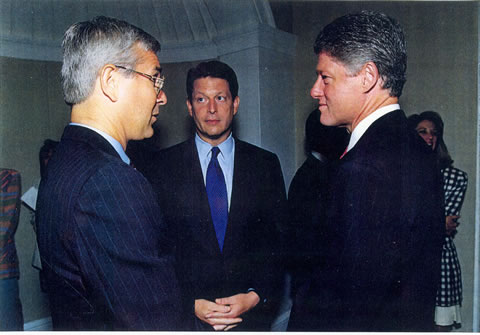
John Mercer discussing government management reform
with President Bill Clinton and Vice President Al Gore
at the White House bill-signing ceremony for
the Government Performance and Results Act on August 3, 1993.
The inspiration for the Government Performance and Results Act of 1993 (GPRA) was the comprehensive, performance-based management and budgeting system of the city of Sunnyvale, California. The system was developed there by then-City Manager Tom Lewcock in the late 1970's and early 1980's. John Mercer had served as Mayor and City Council member in that city during its pioneering implementation of that system, before coming to work in the United States Senate and proposing the idea for GPRA to Senator William V. Roth, Jr. (R-DE) in 1990. Mr Mercer used Sunnyvale's system as the model for his development of that legislation.
The Office of Management and Budget has long spotlighted Sunnyvale's system as an effective approach to performance management and budgeting. In testimony before the Senate Governmental Affairs Committee on May 5, 1992, OMB stated the following:
The City of Sunnyvale, California, stands out as the single best example of a comprehensive approach to performance measurement that we have found in the United States. . . One underlying reason for the success achieved by Sunnyvale is the fact that every program manager uses the system to plan, manage, and assess progress on a day-to-day basis.
Ten years later, OMB continued to praise Sunnyvale's performance budgeting system as a model of effectiveness. In the President's Budget of the United States Government for Fiscal Year 2003 (released February 4, 2002), OMB stated:
Sunnyvale, California has become internationally recognized for performance budgeting - allocating funding for tasks rather than for personnel, equipment, and supplies, with quantified objectives that are expected to be achieved with the funding.
This system is described in an April 1994 paper written by John Mercer, titled "The Performance-Based Management and Budgeting System of the City of Sunnyvale, California" . The paper was published by the Paris-based Organisation for Economic Co-operation and Development (OECD) for distribution to its member nations.
This model system illustrates several key objectives of the President's Management Agenda, a major reform initiative of the George W. Bush administration. As noted above from its Senate testimony, OMB has been impressed with the way Sunnyvale's performance budgeting and management system is used by program managers "to plan, manage, and assess progress on a day-to-day basis." The importance of this characteristic is echoed in one of the original core criteria of the Financial Management reform on the President's Management Agenda:
The Sunnyvale system also illustrates a Budget and Performance Integration standard from the 2002 President's Management Agenda:
Several performance budget examples from this system are shown on this web site. The relationship between this approach to performance budgeting and the federal government reform effort is described both in John Mercer's congressional testimony and in the white paper he wrote, "Performance Budgeting for Federal Agencies" .
This web site includes several newspaper and magazine articles that provide additional description of the role of Sunnyvale's system in inspiring federal government reform.